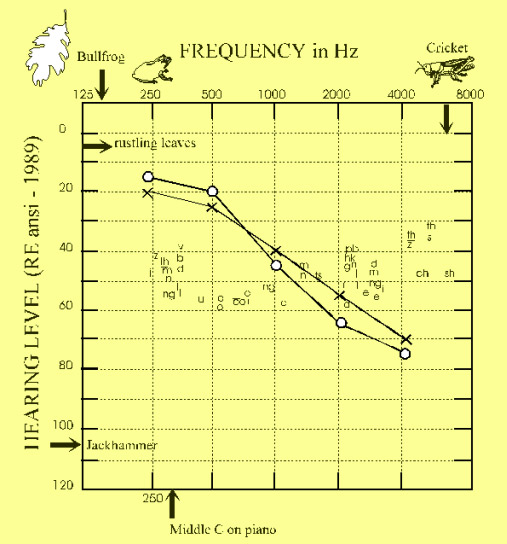What does my audiogram mean?
After you have a hearing test, your audiologist will review the hearing test results on an audiogram. Audiologists are professionals who conduct hearing tests and specialize in evaluating hearing loss. An audiogram is a graph that shows hearing sensitivity. Along the top of the graph are frequencies noted in Hertz. A frequency is also often referred to as pitch. The higher the frequency, the higher the pitch. The sound levels measured in decibels (dB) are located on the left side of the graph. Farther down on the graph means an increase in intensity, or loudness. Your hearing levels in each ear are plotted on the graph to show the softest levels at which you can hear each pitch. The louder sounds must be made to be heard, the greater the degree of hearing loss. A person may have some or all frequencies affected with hearing loss. Different degrees of hearing loss are described below.

Degrees of hearing loss
Those with
mild hearing loss (26-45 dB) typically hear one-on-one conversation if they can see the speaker's face and are listening at close range. With a mild hearing loss, there may be difficulty hearing and understanding soft speech or speech from a distance. Understanding conversation in noisy backgrounds also may be difficult. For young children who are learning speech and language, even a mild hearing loss can have serious effects on speech and language development.
Persons with
moderate hearing loss (45-65 dB) will have difficulty hearing and understanding conversational levels of speech, even in quiet backgrounds. Listening in noise is extremely difficult.
With
severe hearing loss (66-85 dB), hearing is difficult in all situations. Speech may only be detected if a speaker is talking loudly and at close range. Those with
profound hearing loss (≥ 90 dB) do not hear loud speech or environmental sounds.
Shown above is an audiogram of person who has a mild to moderate hearing loss that affects the mid to high frequencies. The right ear is indicated by circles and the left by X’s. The graph also shows the frequency and intensity where sounds of speech typically occur in average conversation.
Types of hearing loss
The ear has three major parts: the external, middle and inner ear. The type of hearing loss depends on which part of the ear is affected. To determine the type, testing is completed with earphones or speakers and another device called a bone conduction transducer. The bone conduction transducer tests only the inner ear.
The
external ear consists of the ear canal and the pinna, which is the part that can be seen. The
middle ear includes the ear drum, three middle ear bones (ossicles) and the Eustachian tube. Hair cells are in the
inner ear, or cochlea. Nerve fibers attached to the hair cells communicate with the brain.
A hearing problem located in the external or middle ear is called a
conductive hearing loss. This type of hearing loss is more likely to respond to medical or surgical treatment. Often a test called a tympanogram is performed to see if there is any evidence of a middle ear problems possibly contributing to the hearing loss.
A hearing problem in the inner ear is called a
sensorineural hearing loss. This kind of hearing loss is usually permanent. Word recognition testing is also typically completed in cases of sensorineural hearing loss. This requires repetition of words at different listening levels to show how clearly speech is heard. The more words that are repeated correctly, the better the word recognition ability.
A problem involving the external/middle ear
and inner ear is called a
mixed hearing loss. Some part of this hearing loss may respond to medical or surgical treatment.
A physician who specializes in treatment of ear and hearing problems (otolaryngologist or otologist) can determine whether the hearing loss could be improved with medical or surgical treatment. A consultation is important to determine if treatment would be beneficial or if additional tests are necessary. A schedule to monitor hearing levels may also be recommended. When treatment is not indicated, your audiologist will discuss if hearing aids are appropriate for you or your child.
What Does my Audiogram Mean?
Hearing and Balance
